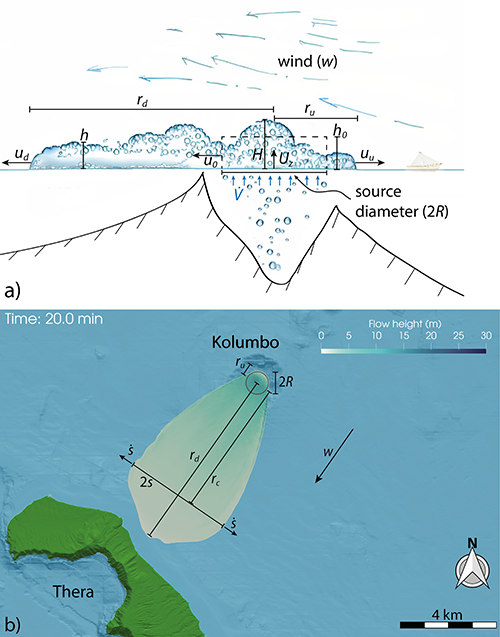Gas transport dynamics at Kolumbo submarine volcano: high-resolution numerical simulations, scaling laws, and hazard implications

Cerminara M., Baxter P., Neri A., Sparks R.S.J., Vaselli O.,
Vougioukalakis G., (2025).
Bulletin of Volcanology 87(112). https://doi.org/10.1007/s00445-025-01903-3
Abstract
The 1650 CE Kolumbo (Greece) submarine eruption resulted in the reported deaths of 50 people and thousands of animals on Santorini (Thera) due to exposure to a cloud of noxious volcanic gases. Lack of ash in the cloud indicates that the gas release was unrelated to a magmatic explosive eruption. Medical evidence from historic accounts suggests lethal exposure to CO₂ and H₂S, which were likely the main hazardous gases, whereas strongly acidic gases such as SO₂, HCl, and HF were less relevant due to their high solubility in seawater. Expert elicitation indicates significant uncertainty, with probabilities of gas releases conditional on the occurrence of an eruption in the next 30 years ranging in 15–58–93% (5th–50th–95th percentiles), and a 2–17–48% likelihood of the gas cloud reaching Thera. A transient 3D multiphase fluid dynamics model (ASHEE) is employed to simulate turbulent gas cloud propagation and dilution under scenarios with source and meteorological conditions informed by expert elicitation and ECMWF-ERA5 2005−2016 data. A novel component of this study is the derivation of analytical predictive relationships through a non-dimensional scaling analysis, based on parameters like the Richardson number. Simple models are presented for weak, intermediate, and strong wind regimes, providing a generalized framework for gas transport and hazard assessment in similar volcanic settings. Results indicate about 50% probability of the gas cloud reaching Thera, even with a relatively modest volumetric flow rate of 10³ m³ s⁻¹ and a wind speed half of the average. However, hazardous concentrations (above 200 ppm of H₂S and 10 vol.% of CO₂) along the NE coast of Thera are reached if source gas flux exceeds 10⁴ m³ s⁻¹. By integrating elicitation outcomes, physical modeling, and probabilistic analysis, his study estimates a 16% and 17% likelihood of hazardous gas exposure for CO₂ and H₂S, respectively, along the NE coast of Thera in case of formation of a gas density current in the next 30 years.



Devi effettuare l'accesso per postare un commento.